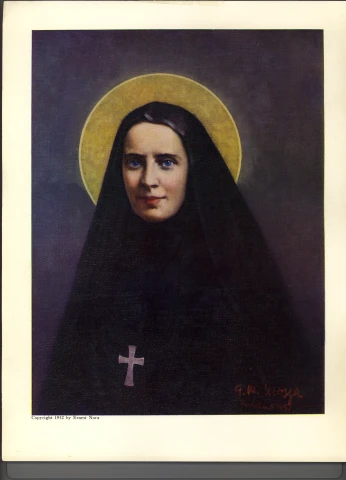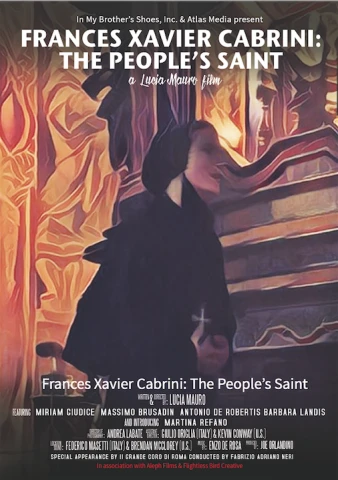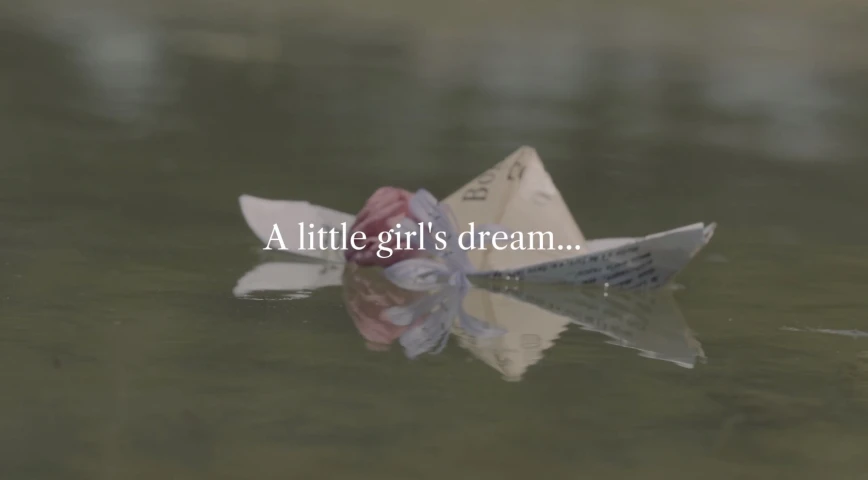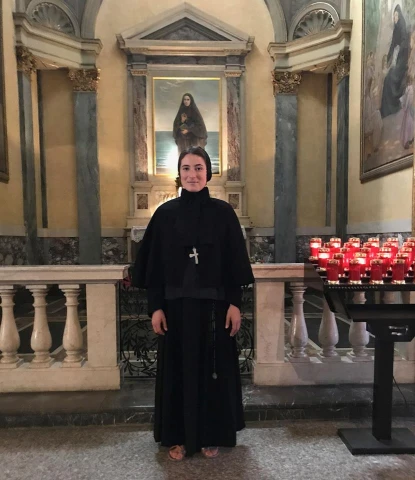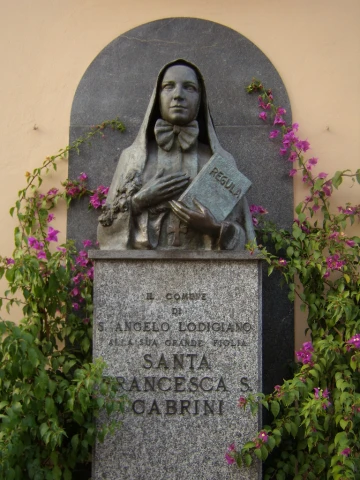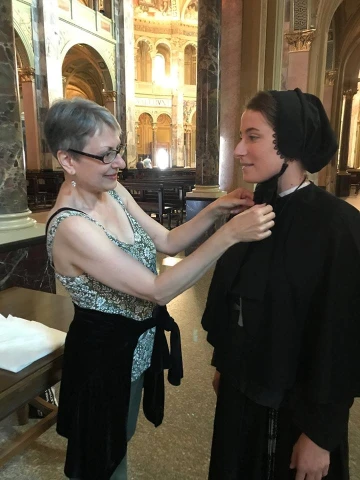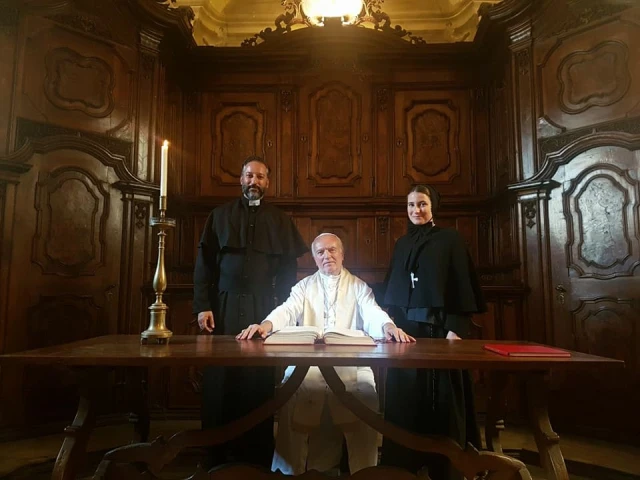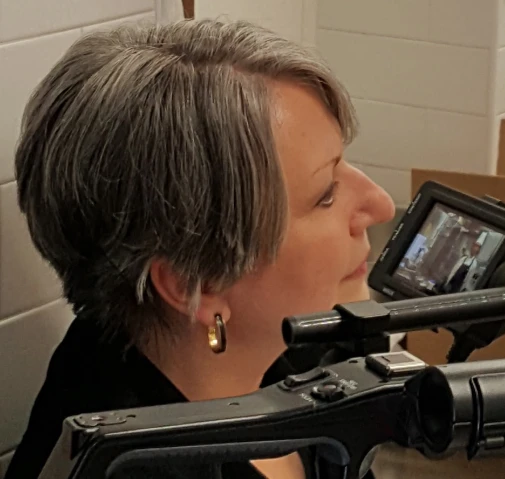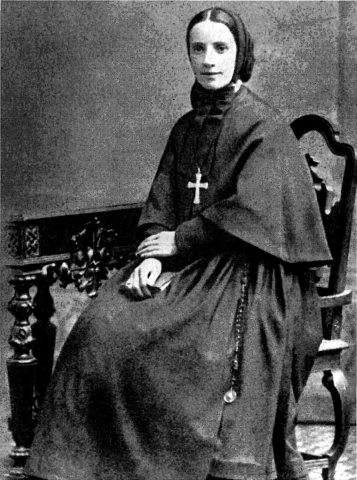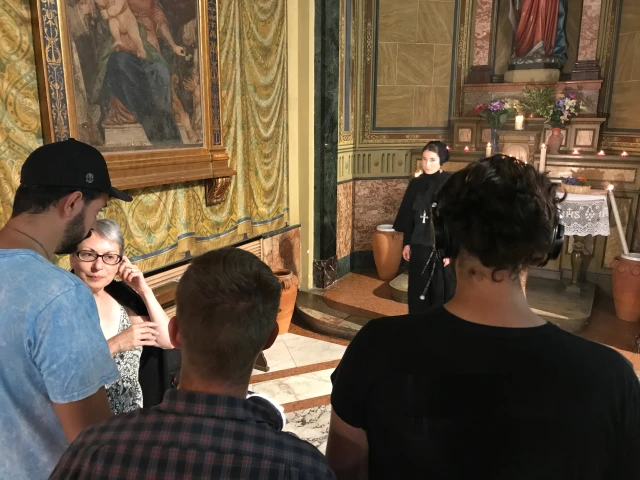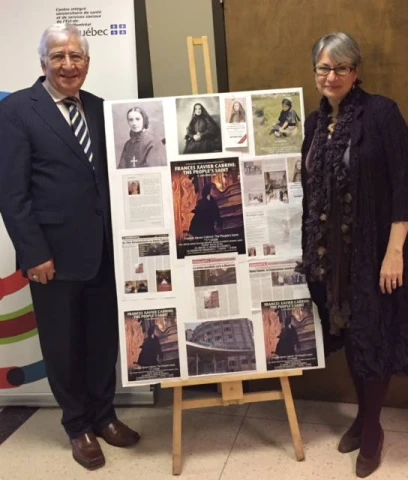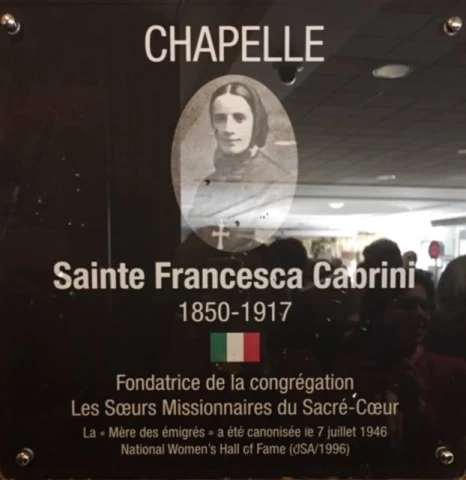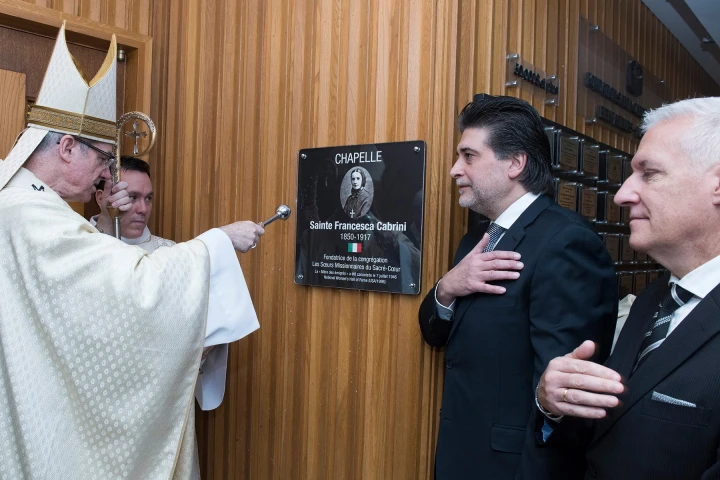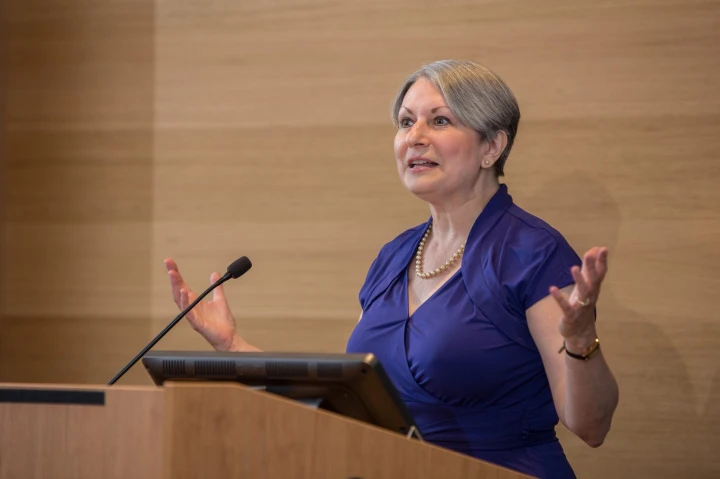The most important Italian emigrant to the US, a marvelous person who spent her whole life helping their fellow Italians and not only them, and then acquired the American citizenship later becoming the first American saint ever: we're talking about Francesca Xavier Cabrini, the Patron Saint of Immigrants and Hospital Administrators.
After being fundamental for the life of hundreds of thousands of immigrants, Mother Cabrini died in Chicago on December 22, 1917. This is why, 100 years after her death, we celebrate her life, her achievements, her commitment and, through her, the experience of those who left Italy in search of a future, and landed in the United States. We do that meeting Lucia Mauro, a talented writer-director and author of "Frances Xavier Cabrini: The People’s Saint", a wonderful film/documentary out in these very days
Lucia, who was Francesca Saverio Cabrini?
Saint Francesca Saverio Cabrini, born in 1850 in Sant’Angelo Lodigiano, Italy and died in 1917 in Chicago, Illinois, was a great humanitarian and humanist who ministered to children, the poor, the sick, and immigrants adapting to life in a new land. She founded the Missionary Sisters of the Sacred Heart of Jesus and is the first naturalized United States citizen to be canonized a saint (1946). While prayer was fundamental to Mother Cabrini, she did not remain behind cloistered walls. She went out into the big world, and despite frail health and a fear of water, she crossed the ocean many times to found orphanages, schools and hospitals (80 institutions). Her reach is global and remains relevant for our times.
How did she become the Patron Saint of Immigrants and Hospital Administrators?
These titles are the result of Mother Cabrini’s tireless work with restoring dignity and faith to the countless Italian immigrants living in tenements in America. Because they did not speak English, they had limited access to education, safe and sanitary housing, and quality healthcare. Pope Leo XIII urged Mother Cabrini to help the immigrants in America. While she was working in New York City, she stepped in to improve conditions at and the financing of a hospital for Italian immigrants originally established by the Scalabrian Brothers. Throughout her life, Mother Cabrini assisted immigrants and her work continues around the world today. I would like to add that, in my film, we feature interviews with immigrants from various parts of Africa, Asia, Central and South America, Mexico, Eastern Europe and more. Mother Cabrini’s spirit lives in them all.
She is famous for the help she gave to the people who emigrated, from Italy but not only, to New York and to Chicago. Colorado was also very important in her life, right?
Yes. Mother Cabrini spent a great deal of time in Denver physically going down into the mines to pray with and bring food to the Italian miners. With mining being such a dangerous occupation and many of the men killed or injured, she raised funds to take care of their widows and children. There is a well-known Shrine to Mother Cabrini in Golden, Colorado. She also did extensive work in New Orleans, Seattle, Philadelphia and Los Angeles. We filmed a lovely fountain at Mother Cabrini’s Casa Natale in Sant’Angelo Lodigiano that show her journey across the globe. It’s also important to note that, having been raised in the agricultural environment of Sant’Angelo Lodigiano, she insisted on establishing her schools, orphanages and hospitals in areas with fresh air and water, gardens and trees. She understood the salutary effects of nature. Even at the end of her life, Mother Cabrini purchased a farm just outside Chicago in order to grow organic produce for the patients at Columbus Hospital.
Mother Cabrini has been named "The most important Italian emigrant to the US". Was there something peculiarly Italian in her?
Absolutely! It’s clear from reading Mother Cabrini’s letters and the descriptions of her by fellow Missionary Sisters that she loved life and was a wonderful pragmatist. Because she was used to living in a country where family is the true core of being – not a government often mired in bureaucracy – she treated her fellow sisters as if they were her daughters. She had a beautiful sense of humor and loved good wine, beer and food – risotto alla Milanese being one of her favorite dishes.
There’s a delightful story about Mother Cabrini in Spain. She found herself traveling with tourists, who stopped in Malaga to buy expensive boxes of the famed local raisins. She thought they were over-priced and not fresh. So she caught sight of a mule hauling a load of fresh-picked raisins; paid the farmer a modest fee; and chose and enjoyed those raisins instead. She was a shrewd businesswoman and a persistent fundraiser. When the businessmen tried to cheat her on the amount of acreage she was purchasing for the site of Columbus Hospital in Chicago, she insisted that she and her fellow sisters measure the plot of land. And she was right. Her natural “Italian” sense of distrust worked in her favor. Mother Cabrini embraced challenges. No matter what types of roadblocks people tossed before her, she saw them as leading to better things.
Let's talk about your film. How did you come up with the idea of working on it?
My film, "Frances Xavier Cabrini: The People’s Saint", is a divine gift that came about unexpectedly. My husband, producer Joe Orlandino, and I presented a screening of my short film, In My Brother’s Shoes – about the brother of a fallen U.S. Marine who takes a healing pilgrimage to Rome in his sibling’s combat boots – at Chicago’s National Shrine of St. Frances Xavier Cabrini in March 2017 for the Lenten season. This film won Best Short Film at the 2015 Mirabile Dictu International Catholic Film Festival at the Vatican.
This year marks the 100th anniversary of Mother Cabrini’s entrance into eternal life. One of the members of the National Shrine’s Centenary Planning Committee was quite moved by our film and asked if we would like to film the upcoming Cardinal’s Mass in December. Instead, I imagined a film showing how Mother Cabrini lives around the world today. I was greatly inspired, and we immediately started raising the production budget. We filmed in Italy in June and in Chicago in July.
The film received its world premiere on Sunday, November 26, 2017 at Santa Cabrini Hospital in Montreal, Quebec, Canada. The film screening was part of the dedication of the hospital’s Chapel to St. Frances Xavier Cabrini. The venue, named for the Patron Saint of Immigrants and Hospital Administrators, was founded in 1960 by the Missionary Sisters of the Sacred Heart of Jesus to serve the many Italian immigrants in Montreal.
Following the world premiere, Frances Xavier Cabrini: The People’s Saint will receive its U.S. premiere on Tuesday, December 5, 2017 at the Bryn Mawr Film Institute, just outside Philadelphia, with sponsorship by Cabrini University of Radnor, Pennsylvania. Cabrini University, founded in 1957, is a residential Catholic institution that welcomes students of all faiths, cultures and backgrounds.
The movie is part fiction and part documentary, with interviews. Who did you talk to?
I like to call this an art film that is an expository documentary. I also want to stress that the film is entirely factual. Mother Cabrini’s life is presented in a more poetic way through a combination of actor reenactments of pivotal moments in her life; archival footage and interviews with individuals who embody her humanitarian qualities. Three actresses portray Mother Cabrini at different stage of her life (childhood, young woman, and at the end of her life). For example, an actress portrays her as a child sending paper boats filled with flowers across the Venera River in Sant’Angelo Lodigiano. She imagined the flowers to be missionary sisters crossing the ocean to China. We also show her life-changing meeting with Pope Leo XIII, who urged her to “go West, not East,” to serve the Italian immigrants in America.
The film includes interviews with individuals from all walks of life, who carry on Mother Cabrini’s work today as the needs of immigrants and other populations continue to evolve. Each interview reveals a different aspect of Mother Cabrini’s life and mission. In Italy, we feature author-scholar Achille Mascheroni, who was born across from the house where Mother Cabrini was born; Sister Maria Regina Canale, who presents a dynamic tour of Mother Cabrini’s birth home in Sant’Angelo and the convent she founded in Codogno; artist Meo Carbone, who paintings are inspired by Mother Cabrini’s work with Italian immigrants; Sister Bridget Zanin, director of Chicago’s National Shrine, as well as the architect who restored the Shrine. There are a number of interviews with new immigrants(African, Latino, Filipino, Burmese, Eastern European, and more) to America about their needs and about the educational work of Youth Ministers.
Original music is composed by Enzo De Rosa (born in Napoli and based in Montreal). In Rome, we filmed Il Grande Coro di Roma singing Enzo’s original Hymn to Mother Cabrini at Sant’Alessio Church.
There are many personal and symbolic touches in the film. For example, the sounds of the bells ringing are from the Basilica of Santa Francesca Cabrini in Sant’Angelo Lodigiano. We filmed the opening sequence of a field, church and the Venera River precisely where Mother Cabrini as a child played. And we were at the Convent that she founded in Codogno on the Feast of the Sacred Heart of Jesus.
Language is very important. The first part of the film is in Italian to show Mother Cabrini’s native land and her close connection to the Italian language. Part Two, which focuses on her work in America, is in English. Part Three, about Mother Cabrini’s global reach, is also in English. However, we highlight immigrants speaking in their own languages, with a scene of a Burmese-language Mass at Saint Ita Church in Chicago.
Will it be available for the Italian market, too?
Yes, the film is in both Italian and English, with corresponding subtitles. Our goal is to take the film to all the places where Mother Cabrini lived and worked … and beyond. We also will be promoting the film for TV broadcast and streaming. More people need to know this powerful and compassionate woman and be inspired by her good works.
Part of your movie is filmed in The National Shrine of St. Frances Xavier Cabrini in Chicago. Please describe this beautiful place to those of our readers who haven't already visited it.
The National Shrine of Saint Frances Xavier Cabrini is a spiritual and architectural wonder saved and restored from the demolition of Columbus Hospital, where it was once hidden from street view for decades. It reopened in 2012 and is located inside a luxury condominium complex. The Shrine contains the meticulously restored chapel, as well as a garden, spacious lobby, and exhibit rooms including a re-creation of the room where St. Frances Xavier Cabrini died while preparing Christmas candy treats for children on December 22, 1917.
Today Italy is a country from which people leave (more than 100,000 Italians emigrate every year) but also one to which many more arrive. We are the first country to meet the wave of those who flee from Africa to seek fortune in Europe: an experience in some ways similar to that with which Mother Cabrini had to deal, but in some ways very different. What would Mother Cabrini do if she lived in Italy today?
I believe we need to start with how dramatically different the immigration situation was during Mother Cabrini’s time compared to today. When Pope Leo XIII redirected her goal of being a missionary in China to helping the newly arrived Italian immigrants in America at the turn of the 20th century, immigrants in America were being greatly exploited and discriminated against. They were enticed by American entrepreneurs and politicians to help build a burgeoning new country (railroad workers, laborers, miners, stonemasons, etc.) with the promise of prosperity. Many ultimately achieved the American Dream, especially for subsequent generations. But, in most cases, immigrants at that time were welcomed as a source of cheap labor.
They were simultaneously accepted for their ability to help expand the country’s businesses and infrastructures, and shunned for being perceived as poor and lower class. They were initially escaping poverty, but they also were given an opportunity to prosper over time in their adopted country. This is quite different from the wave of refugees and immigrants from Africa, the Middle East and Eastern Europe pouring in overwhelming numbers into Italy and other parts of Europe. They are fleeing out of utter and total desperation from war, terrorism and extreme poverty to a country, such as Italy, which has been in the midst of an economic crisis for a long time. Though humanitarian organizations have been created to improve refugees’ situations, great tension and hostility has developed between them and the local people who feel they are taking away work from a country already experiencing high unemployment and economic distress.
So to answer the question of what would Mother Cabrini do if she had lived in Italy today, I honestly don't think she would be living in Italy today. Mother Cabrini was constantly traveling and serving those in need around the world. Besides her desire to be a missionary in China, she wanted to assist those in need in Africa – but that’s one of the few continents she was not able to travel to. She spent a great deal of time in South America (Nicaragua, Panama, Argentina, Brazil), and established missions, schools and orphanages despite oppressive regimes. I truly believe she would have been creating humanitarian programs directly in the countries facing crises today.
La più importante italiana emigrata negli Stati Uniti, una persona meravigliosa che ha trascorso tutta la sua vita aiutando i suoi connazionali e non solo loro, e che ha poi acquisito la cittadinanza americana diventando in seguito il primo Santo americano di sempre: parliamo di Francesca Saverio Cabrini, la Santa Patrona degli Immigrati e del personale ospedaliero.
Dopo essere stata fondamentale per la vita di centinaia di migliaia di immigrati, Madre Cabrini morì a Chicago il 22 dicembre 1917. Per questo, 100 anni dopo la sua morte, celebriamo la sua vita, le sue conquiste, il suo impegno e, attraverso di lei, l'esperienza di chi lasciò l'Italia alla ricerca di un futuro, e approdò negli Stati Uniti. Lo facciamo incontrando Lucia Mauro, talentuosa scrittrice-regista e autrice di "Frances Xavier Cabrini: The People’s Saint", un meraviglioso film/documentario uscito in questi giorni
Lucia, chi era Francesca Saverio Cabrini?
Santa Francesca Saverio Cabrini, nata nel 1850 a Sant'Angelo Lodigiano, in Italia e morta nel 1917 a Chicago, Illinois fu una persona di una grande umanità che aiutò i bambini, i poveri, i malati e gli immigrati adattandosi alla vita in una nuova terra. Fondò le Suore Missionarie del Sacro Cuore di Gesù, e fu la prima cittadina naturalizzata degli Stati Uniti ad essere canonizzata santa, nel 1946. La preghiera era fondamentale per Madre Cabrini, ma non rimase certo solo dietro le mura di clausura. Uscì nel grande mondo, e nonostante una salute fragile e la paura dell'acqua, attraversò l'oceano molte volte per fondare orfanotrofi, scuole e ospedali (80 istituzioni in totale). La sua eredità è globale e rimane rilevante anche per i nostri tempi.
Come è diventata la Santa Patrona degli Emigrati e degli operatori ospedalieri?
Questi titoli sono il frutto dell'instancabile lavoro di Madre Cabrini, che restituì dignità e fede agli innumerevoli immigrati italiani che vissero in condizioni precarie una volta arrivati in America. Poiché non parlavano inglese, avevano un accesso limitato all'istruzione, a alloggi sicuri e igienici e a un'assistenza sanitaria di qualità. Papa Leone XIII esortò Madre Cabrini ad aiutare gli immigrati in America. Mentre lavorava a New York, Madre Cabrini si diede molto da fare per migliorare le condizioni e il finanziamento di un ospedale per immigrati italiani originariamente fondato dai Fratelli Scalabriniani. Nel corso della sua vita, Madre Cabrini assistette tantissimi immigrati e il suo lavoro continua oggi in tutto il mondo. Vorrei aggiungere che nel mio film abbiamo intervistato immigrati provenienti da varie parti dell'Africa, dell'Asia, dell'America centrale e meridionale, dal Messico, dall'Europa orientale e molto altro ancora. Lo spirito di madre Cabrini vive in tutti loro.
Madre Cabrini è famosa per l'aiuto che diede agli emigrati, dall'Italia ma non solo, a New York e a Chicago. Ma anche il Colorado fu molto importante nella sua vita, giusto?
Sì. Madre Cabrini trascorse molto tempo a Denver, scendendo fisicamente nelle miniere per portare cibo ai minatori italiani e pregare con loro. Avendo a che fare con un'attività mineraria così pericolosa, che uccise o ferì molti uomini, Madre Cabrini raccolse anche fondi per prendersi cura delle loro vedove e dei loro figli. C'è un Santuario molto noto, dedicato a Madre Cabrini, a Golden, in Colorado. Prestò aiuto anche ad altri immigrati a New Orleans, Seattle, Philadelphia e Los Angeles. Nel film ci sono alcune scene che comprendono una meravigliosa fontana che è presso la Casa Natale di Madre Cabrini a Sant'Angelo Lodigiano, che mostra i suoi viaggi nel mondo. Importante è anche il fatto che, essendo cresciuta nell'ambiente agricolo di Sant'Angelo Lodigiano, insistette per istituire le sue scuole, i suoi orfanotrofi e i suoi ospedali in aree con aria fresca e acqua, giardini e alberi. Madre Cabrini comprendeva gli effetti salutari della natura: verso la fine dei suoi giorni acquistò una fattoria appena fuori Chicago per coltivare prodotti biologici per i pazienti del Columbus Hospital.
Madre Cabrini è stata nominata "l'immigrata di origine italiana più importante negli Stati Uniti". C'era qualcosa di particolarmente italiano in lei?
Assolutamente! Dalla lettura delle lettere di Madre Cabrini e da come la descrivevano le sue Suore Missionarie, si evince chiaramente che amava la vita ed era una persona pratica e pragmatica. Siccome era abituata a vivere in un Paese dove la famiglia è il vero nucleo dell'essere - non un governo spesso impantanato nella burocrazia - trattava le sue sorelle come se fossero figlie. Aveva un bel senso dell'umorismo e amava il buon vino, la birra e il cibo - il risotto alla milanese era uno dei suoi piatti preferiti.
C'è una storia deliziosa su Madre Cabrini in Spagna. Si ritrovò a viaggiare con alcuni turisti, che si fermarono a Malaga per comprare le costose scatole della famosa uva passa locale. Madre Cabrini pensava che fossero troppo costose e che non contenessero un prodotto fresco. Così, q1uando vide un mulo che trasportava un carico di uvetta fresca appena raccolta, pagò il contadino con qualche spicciolo, e si godette l'uva fresca invece di quella più costosa e confezionata. Era un'avveduta imprenditrice che non sprecava i soldi da destinare a fare del bene. Quando alcuni uomini d'affari cercarono di imbrogliarla sulla quantità di superficie che stava acquistando per il sito del Columbus Hospital di Chicago, Madre Cabrini insistette affinché lei e le sue sorelle misurassero il terreno. Ed ebbe ragione. Il suo naturale senso di diffidenza "italiano" lavorava in suo favore. Madre Cabrini accettò sempre le sue sfide. Non importa quali tipi di ostacoli le persone le mettevano davanti, per lei erano sempre occasioni per migliorare le cose.
Parliamo del tuo film. Come è nata l'idea di realizzarlo?
Il mio film, "Frances Xavier Cabrini: The People’s Saint", è un dono del cielo che si è verificato inaspettatamente. Mio marito (il produttore Joe Orlandino) ed io abbiamo presentato una proiezione del mio cortometraggio "In My Brother's Shoes" – che parla del fratello di un Marine americano morto in guerra che fa un pellegrinaggio a Roma per superare il lutto con gli stivali da combattimento di suo fratello - al National Shrine of St. Frances Xavier Cabrini di Chicago nel marzo 2017, per la stagione quaresimale. Questo film ha vinto il miglior cortometraggio al Mirabile Dictu International Catholic Film Festival del 2015 in Vaticano.
Quest'anno ricorre il centenario dell'ingresso di Madre Cabrini nella vita eterna. Uno dei membri della Commissione per la pianificazione del centenario del National Shrine è rimasto molto commosso dal nostro film, e ci ha chiesto se volessimo filmare la Messa del Cardinale che sarebbe stata tenuta a dicembre. Invece, io ho immaginato un film che mostrasse come Madre Cabrini vive ancora oggi in tutto il mondo. Ebbi da questo una grande ispirazione e iniziammo immediatamente ad aumentare il bilancio di produzione. Abbiamo girato in Italia a giugno e a Chicago a luglio.
Il film ha avuto al sua premiere mondiale al Santa Cabrini Hospital di Montreal, in Canada, la scorsa domenica 26 Novembre. La proiezione è stata parte della cerimonia che ha intitolato a Santa Francesca Saverio Cabrini la cappella dell'Ospedale. Questa istituzione, chiamata così in onore della Santa Patrona degli immigrati e degli operatori ospedalieri, fu fondata nel 1960 dalle Suore Missionarie del Sacro Cuore di Gesù per aiutare i tanti immigrati italiani a Montreal.
Dopo la prima mondiale, "Frances Xavier Cabrini: The People's Saint" debutterà per la prima volta negli Stati Uniti martedì 5 dicembre 2017 presso il Bryn Mawr Film Institute, appena fuori Philadelfia, con il patrocinio della Cabrini University di Radnor, Pennsylvania. La Cabrini University, fondata nel 1957, è un'istituzione cattolica che accoglie studenti di tutte le fedi, culture e tradizioni.
Il film è parte fiction e parte documentario, e ci sono anche alcune con interviste. Chi sono le persone con cui hai parlato?
A me piace definire questo film d'arte un documentario espositivo. Voglio anche sottolineare che il film è del tutto attinente alla realtà. La vita di Madre Cabrini è presentata in modo poetico attraverso una combinazione di rievocazioni di momenti cruciali della sua vita, filmati d' archivio e interviste con persone che incarnano le sue qualità umanitarie. Tre attrici ritraggono Madre Cabrini in diverse fasi della sua vita (figlia, giovane donna e alla fine della sua vita). Ad esempio, un'attrice la ritrae da bambina, mentre invia barche di carta piene di fiori attraverso il fiume Venera a Sant'Angelo Lodigiano. Immaginava che i fiori fossero sorelle missionarie che attraversavano l'oceano verso la Cina. Mostriamo anche l'incontro che cambiò la sua vita con Papa Leone XIII, che la esortò ad "andare ad Occidente, non ad Oriente", per aiutare gli immigrati italiani in America.
Il film include interviste a persone di tutti i ceti sociali, che portano avanti il lavoro di Madre Cabrini oggi che i bisogni degli immigrati e di altre popolazioni continuano ad evolversi. Ogni intervista rivela un aspetto diverso della vita e della missione di Madre Cabrini. In Italia, troviamo l'autore nonché accademico Achille Mascheroni, nato di fronte alla casa natale di Madre Cabrini; Suor Maria Regina Canale, che presenta un interessante tour della casa natale di Madre Cabrini a Sant'Angelo e del convento da lei fondato a Codogno; l'artista Meo Carbone, che dipinge ispirandosi al lavoro di Madre Cabrini in favore degli immigrati italiani; Suor Bridget Zanin, direttrice del National Shrine di Chicago e architetto che ha restaurato il Santuario. Ci sono una serie di interviste con nuovi immigrati negli Stati Uniti (da Africa, America Latina, Filippine, Birmania, Europa dell'Est e molti altri Paesi) che ci parlano delle loro necessità e del lavoro educativo svolto dai Ministri della Gioventù.
La musica originale è composta da Enzo De Rosa (nato a Napoli e residente a Montreal). A Roma abbiamo filmato Il Grande Coro di Roma mentre cantava l'originale inno di Enzo a Madre Cabrini, presso la Chiesa di Sant'Alessio.
Ci sono molti elementi personali e simbolici nel film. Ad esempio, i suoni delle campane sono quelli della Basilica di Santa Francesca Cabrini a Sant'Angelo Lodigiano. Abbiamo girato la sequenza di apertura di un campo, di una chiesa e del fiume Venera, proprio dove giocava Madre Cabrini da bambina. E siamo stati al convento che lei fondò a Codogno, durante la festa del Sacro Cuore di Gesù.
La lingua è molto importante. La prima parte del film è in italiano per mostrare la patria di Madre Cabrini e il suo stretto legame con la lingua italiana. La seconda parte, che si concentra sul suo lavoro in America, è in inglese. Anche la terza parte, riguardante la portata globale di Madre Cabrini, è in inglese. Tuttavia, celebriamo gli immigrati che parlano nella loro lingua, con una scena di messa in lingua birmana presso la chiesa di Santa Ita a Chicago.
Il film sarà disponibile anche per il mercato italiano?
Sì, il film è in italiano e inglese, con i relativi sottotitoli. Il nostro obiettivo è quello di portare il film in tutti i luoghi dove Madre Cabrini ha vissuto e lavorato ... e oltre. Promuoveremo il film anche affinché venga trasmesso in tv e in streaming. Vogliamo che il numero maggiore di persone possibili conosca questa donna potente e compassionevole e venga ispirato dalle sue buone azioni.
Parte del tuo film è girato nel Santuario Nazionale di Santa Francesca Saverio Cabrini a Chicago. Ti chiediamo di descrivere questo meraviglioso posto ai nostri lettori
Il National Shrine of Saint Frances Xavier Cabrini è una meraviglia spirituale e architettonica salvata e restaurata dalla demolizione del Columbus Hospital, dal quale per decenni è stato nascosto dalla vista del pubblico che passava di lì. Riaperto nel 2012, si trova all'interno di un lussuoso complesso residenziale. Il Santuario contiene la cappella restaurata meticolosamente, così come un giardino, uno spazioso salone e spazi espositivi che includono una ricostruzione della stanza dove Santa Francesca Cabrini morì durante la preparazione del Natale per i bambini, il 22 dicembre 1917.
Oggi l'Italia è un Paese da cui partono molte persone (più di 100.000 italiani emigrano ogni anno) ma dove ne arrivano tante. Geograficamente siamo il primo Paese che incontra l'ondata di coloro che fuggono dall'Africa per cercare fortuna in Europa: un'esperienza in qualche modo simile a quella che affrontare Madre Cabrini, ma in qualche modo anche molto diversa. Cosa farebbe Madre Cabrini se vivesse oggi in Italia?
Credo che si debba iniziare da quanto fosse drammaticamente diversa la situazione dell'immigrazione al tempo di Madre Cabrini rispetto a oggi. Quando Papa Leone XIII le chiese di sviluppare la sua missione non più verso la Cina quanto piuttosto verso l'America, per aiutare i nuovi arrivati italiani all'inizio del XX secolo, gli immigrati in America erano molto sfruttati e discriminati. Da lavoratori ferroviari, operai, minatori, scalpellini, vennero attirati da imprenditori e politici americani per contribuire alla costruzione di un nuovo fiorente Paese con la promessa di prosperità. Molti alla fine costruirono il loro sogno americano, soprattutto per le generazioni successive. Ma, nella maggior parte dei casi, gli immigrati in quel momento furono accolti essenzialmente come fonte di manodopera a basso costo.
Furono accettati per la loro capacità di contribuire all'espansione delle attività e delle infrastrutture degli Stati Uniti, e allo stesso tempo esclusi dalla società poiché percepiti come poveri e di classe inferiore. All' inizio fuggivano dalla povertà, ma ebbero l'opportunità di prosperare, col tempo, nel loro Paese di adozione. Questo è molto diverso dall'ondata di rifugiati e immigrati provenienti dall'Africa, dal Medio Oriente e dall'Europa dell'Est che si riversano in massa in Italia e in altre parti d'Europa. Fuggono dalla totale disperazione della guerra, del terrorismo e dell'estrema povertà in Paesi, come l'Italia ad esempio, che da molto tempo attraversano una crisi economica. In Italia, sebbene siano state create organizzazioni umanitarie per migliorare la situazione dei rifugiati, si sono sviluppate grandi tensioni e ostilità tra loro e le popolazioni locali che si sentono private del lavoro in un Paese che già soffre di un alto tasso di disoccupazione e disagio economico.
Quindi, per rispondere alla domanda su cosa farebbe Madre Cabrini se vivesse al giorno d'oggi, onestamente non credo che oggi vivrebbe in Italia. Madre Cabrini era costantemente in viaggio e al servizio di coloro che si trovavano in difficoltà, in tutto il mondo. Oltre al suo desiderio di essere missionaria in Cina, voleva aiutare i bisognosi in Africa - ma questo è uno dei pochi continenti in cui non è riuscita a viaggiare. Ha trascorso molto tempo in Sud America (Nicaragua, Panama, Argentina, Brasile) e ha fondato missioni, scuole e orfanotrofi nonostante i regimi oppressivi. Credo sinceramente che avrebbe creato programmi umanitari direttamente nei Paesi che oggi si trovano ad affrontare le crisi.


